The allure of raised garden beds is not new, and although they are impressive focal points, their origins are much more practical than aesthetic. Raised beds were initially created to deal with problems like poor or rocky soil, no soil, poor drainage, erosion issues and soil compaction. It used to be that raised beds were constructed primarily from wood — but no more. Today there are many stylish and practical materials to use in addition to wood, like concrete, stone and even steel.
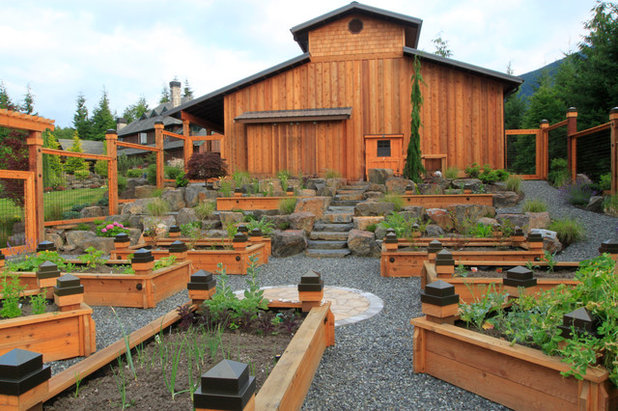
Alderwood Landscape Architecture and Construction
WoodThis is probably the most common material for constructing raised beds, and perhaps one of the least expensive. Use naturally rot-resistant woods like cedar or redwood, and avoid woods preserved with toxins, such as creosote-soaked railroad ties. Pressure-treated wood is treated with alkaline copper quaternary, which the EPA considers safe for food crops, but you may still want to line your beds with weed barrier fabric to avoid the soil's coming into contact with the wood.
Pros: Wood raised beds are easy to install, and the material is readily available in most areas. They work nicely for traditional as well as more contemporary gardens, depending upon the design and construction of the beds. Wooden raised beds are a perfect project for the avid DIYer. Wood is also one of the most cost-effective choices for constructing raised beds.
Cons: Wood doesn't last forever, so at some point you will need to replace it. Still, untreated wood can last for a number of years (up to 10) without really noticeable rot, and treated wood will last even longer.
Cost: Depending on the size of your bed, cedar or redwood could cost up to $150 per bed; pressure-treated wood costs $75 to $100.
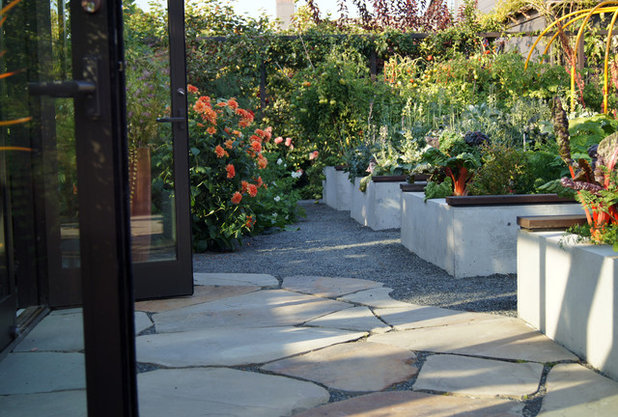
Berger Partnership
ConcreteThe use of urban landscape elements like concrete has increased in recent years. What used to seem ordinary and humble can now be chic and even trendy, making concrete a very flexible and desired addition to most types of gardens.
Pros: When properly installed, concrete walls can last indefinitely. They can also work well in traditional, contemporary or even global styles (think Spanish courtyard or Mexican stucco), and can be tinted to blend, match or contrast with your home and other structures.
Cons: Concrete can be expensive and is not a project for the DIYer in most cases.
Cost: The materials are fairly inexpensive, but the labor is more intensive, so the overall cost is not necessarily on the low end of the options. Expect to pay about $30 per square foot, but that cost could significantly increase if you have issues, like a sloping yard, that will make the prep work more difficult.
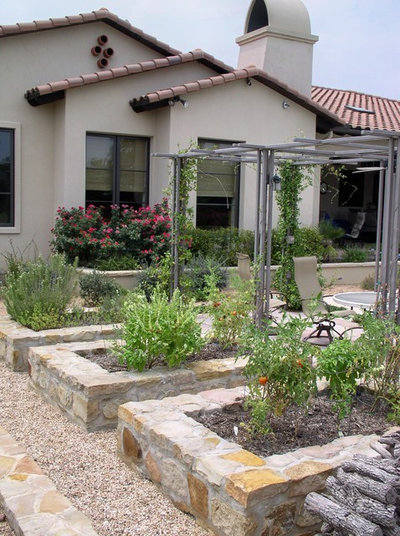
Rick O'Donnell Architect
MasonryMasonry raised beds are the chameleons of the garden world. They can easily fit into nearly any style of garden, depending upon the type of rock you use. If you are a handy DIYer, you may be able to complete a project like this on your own, but most homeowners will want to hire a masonry crew to install the beds properly.
Pros: Masonry can be a permanent addition, and the supplies are available almost everywhere. Masonry raised beds are very attractive and can be built to blend in with or even match your home's exterior.
Cons: Masonry can be fairly costly, depending on the type of rock.
Cost: Most masons charge by the linear or square foot; for raised beds expect to pay $5 to $10 per square foot, or more if you choose a higher-priced rock.
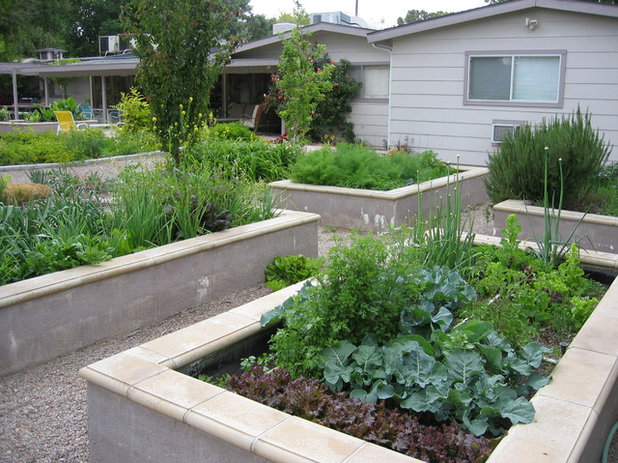 Cinderblock
CinderblockRaised beds made from cinderblock can be constructed in a number of different ways. Cinderblocks can simply be stacked to the desired height of the bed, or they can be mortared in place and then given a more elegant finish with a surface treatment and capped tops, as shown here. The former is much more rustic and inexpensive, while the latter is more elegant and pricier.
Pros: Cinderblock is very inexpensive and widely available; you can purchase it at home improvement stores or building supply stores. It can fit a wide range of aesthetics, from rustic to urban to elegant, depending on the application. It's also fairly durable and will stay in place for many years.
Cons: Individual pieces are fairly heavy, making this project difficult to do solo.
Cost: There are a few different styles of cinderblock; materials alone cost about $9 to $15 per square foot. If you hire a professional and add a cap stone and a surface treatment like stucco, plan on triple that cost.
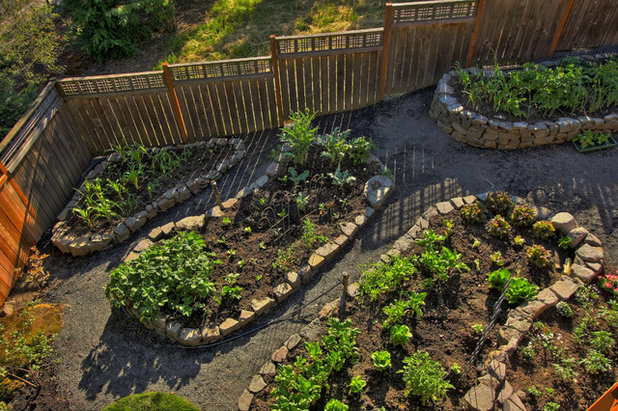
Paradise Restored Landscaping & Exterior Design
RockConstructing raised beds from rock is a very easy DIY project for the average homeowner. Small boulders or large cobbles can be used, and they needn't be mortared in place, assuming your wall is fairly low (12 inches or less, still a respectable height for raised beds). The beds can be straight or curved, like the ones shown here, and larger rocks can simply be pushed up against one another, while smaller ones can nestle together to create a border.
Pros: Rock can create a very casual, cottage-y look, and it's an easy DIY project for most homeowners. This type of construction requires no special equipment, and the materials are widely available.
Cons: Stacked or nestled rocks do not work with every type of landscape style. This type of construction isn't permanent, but that can also be considered an asset if you decide to change the shape or location of your beds.
Cost: If you already have rocks on your property, they're obviously free. If not, prepare to spend $85 a cubic yard and up. Rock is sold by the cubic yard, pound or ton, so inquire how the price is determined for the type of rock you'd like to use before you purchase it.
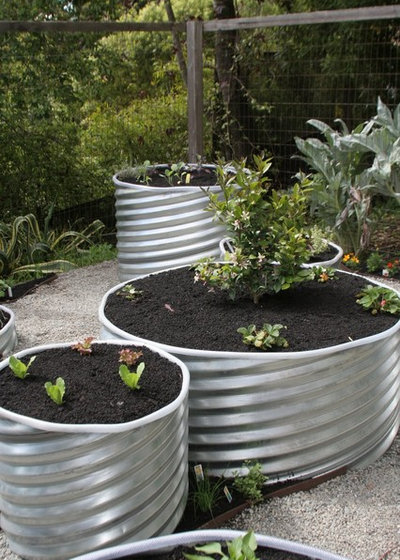
NATALIE SERDIUK
Galvanized CulvertGalvanized culverts are typically used for drainage under roadways, but when sliced into sections, they can make wonderfully stylish planters for a contemporary garden. Many building supply stores carry culverts, but you can also look online for "free for pickup" culverts that are being disposed of.
Pros: Culverts have a cool contemporary look, are fairly readily available, are easy to install (no assembly required) and can be a permanent feature in your garden. In addition, you will have more control over the height and overall size of your planter than you would if you used stock tanks.
Cons: You might have to call around to locate exactly what you want, and when you find a length of pipe in the desired width, you will need to pay to have it cut into sections to use as planters. To transport the sections home, you will need a truck or you will have to arrange for delivery, usually at an additional cost. Culverts are more expensive than galvanized stock tanks.
Cost: Culverts typically come in 20- to 30-foot lengths and a wide variety of widths. You could get 15 2-foot-tall, 36-inch-wide planters for about $900.
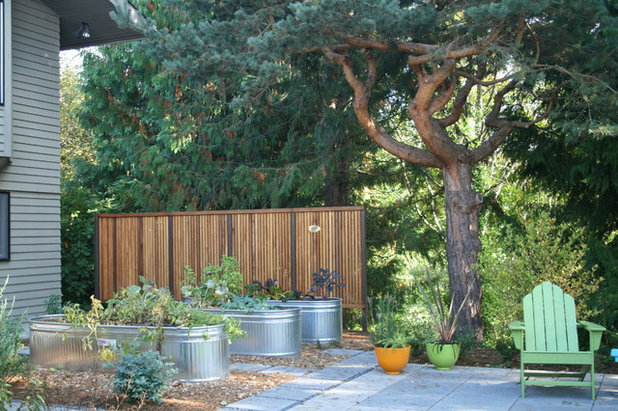
Banyon Tree Design Studio
Stock TanksThis may be one of the easiest options for raised garden beds. Stock tanks, which are typically round or rectangular with rounded ends, are generally used to feed farm animals, but they've been gaining popularity in recent years as a great way to add urban chic to the garden. The only real work you will have to do is add some drainage holes to the bottom of the tank, which is easily completed with a drill and a ¼- or ½-inch drill bit.
Pros: Stock tanks are readily available at feed stores and are relatively inexpensive. There is no assembly required, and they will last indefinitely. They are also movable, which is handy if you redesign your garden layout. They come in a variety of sizes.
Cons: You'll have to have a truck to transport stock tanks home or arrange for a delivery at an added cost. The sides of the tanks can heat up during the summer, but it's typically not a scorching heat that will burn skin.
Cost: Stock tanks typically run $30 to $150, depending on the size.
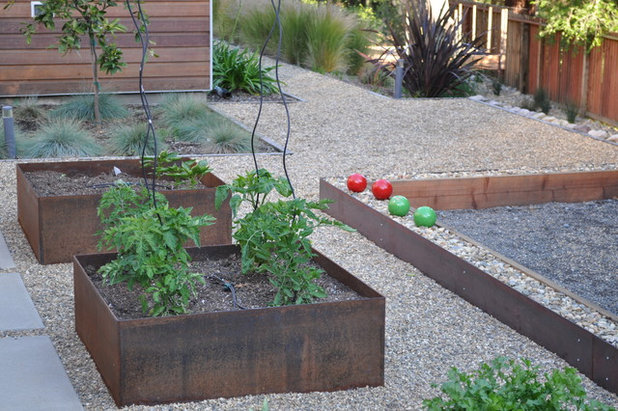
Huettl Landscape Architecture
SteelIndustrial elements like steel add a touch of rustic sophistication to any landscape. Steel, or more precisely Cor-Ten, is commonly used in landscape and construction projects, and comes in sheets that are 3/16 or ¼ inch thick. When it's installed, it starts out a natural steel color and then beautifully weathers to a stunning rusty patina. There are chemical processes that can create the rusty patina immediately, but care must be used in its application to avoid a rusty runoff into nearby plantings or patios.
Pros: Steel is a newer material in today's gardens, so it creates it an up-to-date aesthetic. It also provides a slim profile where you want the beds to be defined but with a less bulky perimeter. It's naturally weather resistant, making it a long-term addition.
Cons: This type of raised bed is best left to the pros, as installation can be difficult and the material is heavy. It's much more costly and may not be available in all areas. It's also not recommended for areas that receive salt spray from the ocean, as that can rapidly deteriorate the material. Steel can add to the heat of your soil, so it may not be the best choice for heat-sensitive plants. The material itself can heat up more quickly than other raised bed materials, so I've found it helpful to place it in a partly shaded area or use plants that don't cascade over the hot edges.
Cost: A simple Cor-Ten rectangular planter box (2 by 6 feet) could run $1,200 or more, depending on where you live.





